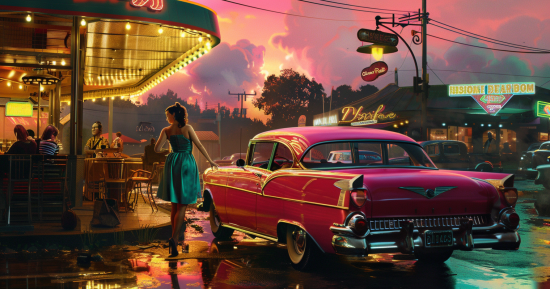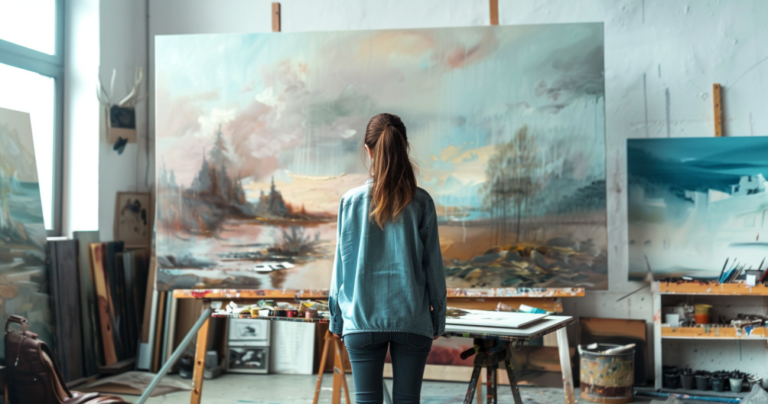Have you ever looked at a painting and wondered why it works so well? The secret lies in composition, a fundamental aspect of visual art. Composition refers to the thoughtful arrangement of visual elements within a work to create a pleasing and compelling whole.
It’s like the invisible scaffolding that holds the artwork together, guiding your eye and evoking emotions. When you understand composition, you’ll see art in a new light. You’ll notice how artists use lines, shapes, colors, and space to lead your gaze through their creations.
What Does Composition Mean in Art
From the balanced scenes of classical paintings to the dynamic compositions of modern art, every choice an artist makes contributes to the overall impact of their work.
Whether you’re an aspiring artist or simply an art enthusiast, grasping the basics of composition can enhance your appreciation of visual art. You’ll begin to recognize the principles of balance, movement, and contrast artists employ to communicate their ideas and evoke specific responses from viewers.
So next time you’re admiring a masterpiece, take a moment to consider its composition – you might be surprised by what you discover!
Understanding Composition in Art

Elements of Composition
The building blocks of composition include line, shape, color, texture, and space. Lines direct your gaze across the artwork, while shapes define areas and create focal points. Color sets the mood and can highlight essential elements. Texture adds depth and visual interest, whether real or implied.
Space encompasses both positive areas occupied by objects and hostile areas around them. As you examine artworks, notice how these elements interact. A bold red shape may command attention, while subtle texture variations add richness. The interplay of light and dark creates depth and dimension.
Principles of Design
Artists employ design principles to organize compositional elements effectively. Balance distributes visual weight, creating stability or tension as desired.
Contrast emphasizes differences between elements, while unity ties the work together cohesively. Rhythm establishes visual patterns that lead your eye through the piece.
Consider how artists use emphasis to highlight critical areas and movement to guide your gaze. Proportion and scale relationships between elements can create drama or harmony. As you view art, look for these principles in action. You might spot symmetrical balance in a portrait or dynamic movement in an abstract piece.
Role of Balance and Harmony

Balance and harmony work together to create visually pleasing compositions.
Symmetrical balance divides the artwork evenly, while asymmetrical balance uses uneven but equally weighted elements.
Radial balance arranges elements around a central point. Harmony unifies diverse elements by repeating colors, shapes, or textures. Artists use these concepts to evoke specific feelings.
A serene landscape might employ symmetrical balance and harmonious colors. In contrast, an energetic piece could feature asymmetrical balance and bold contrasts. As you explore art, consider how balance and harmony contribute to the overall impact.
Does the composition feel stable or dynamic? Unified or diverse?
These choices shape your experience of the artwork.
Analyzing Artistic Composition

Composition Techniques and Styles
Artists use various techniques to guide the viewer’s eye and create balanced scenes.
The rule of thirds divides the canvas into a 3×3 grid, placing key elements along these lines or at their intersections.
Leading lines draw attention to focal points, while symmetry creates a sense of order and balance. Asymmetrical compositions can add dynamic tension. You might see the golden ratio used to create pleasing proportions.
Negative space, the empty areas around subjects, can be just as important as the subjects themselves. Color and value contrasts help direct focus and create depth. Repetition of shapes or patterns can unify a piece, while varying scale adds interest and perspective.
Impact of Composition on Viewer’s Experience
Composition significantly influences how you perceive and interact with artwork. A well-composed piece can evoke specific emotions or guide your interpretation. Balanced compositions often feel stable and harmonious, while asymmetrical ones may create tension or excitement.
The arrangement of elements can affect the narrative or message of the artwork. Focal points draw attention to critical areas, helping you understand the artist’s intent. Spatial relationships between objects can create a sense of depth or flatten the image.
Composition can also impact the overall mood. Open, airy compositions might feel peaceful, while crowded, busy ones could convey energy or chaos. By understanding these effects, you can better appreciate the artist’s choices and their impact on your viewing experience.
Frequently Asked Questions – What Does Composition Mean in Art
In the realm of media arts, how is composition typically understood?
In media arts, composition extends beyond static visual elements to include time-based and interactive components. You might encounter composition in film framing, video game level design, or multimedia installations. Media artists consider factors like timing, pacing, and user interaction when composing their works. This dynamic approach to composition creates engaging experiences across various digital and interactive platforms.
How can one describe composition in visual arts?
You can describe composition in visual arts as the arrangement of visual elements within an artwork. It involves how artists organize shapes, colors, lines, and other components to create a cohesive and impactful piece. When examining a composition, you might notice how the artist uses balance, contrast, and focal points to guide your eye through the work.
Can you give examples of composition in art?
Some common examples of composition in art include the rule of thirds, symmetrical balance, and the golden ratio. The rule of thirds divides the canvas into a 3×3 grid, placing key elements along these lines or at their intersections. Symmetrical balance creates a mirror-like effect, while the golden ratio uses mathematical proportions for aesthetically pleasing arrangements.
What are the different types of composition in painting and drawing?
In painting and drawing, you’ll encounter various composition types.
These include linear composition, which uses lines to guide the viewer’s eye, and radial composition, where elements radiate from a central point.
Other types are triangular composition, forming a stable pyramid shape, and asymmetrical composition, creating dynamic tension through uneven distribution of elements.
What are the seven rules of composition in art that artists follow?
Artists often follow these seven composition rules:
1. Balance
2. Contrast
3. Emphasis
4. Pattern
5. Proportion
6. Movement
7. Unity
These principles help create visually appealing and harmonious artworks.
Artists apply these rules in various combinations to achieve their desired effects, demonstrating the practical application of these principles in art.






